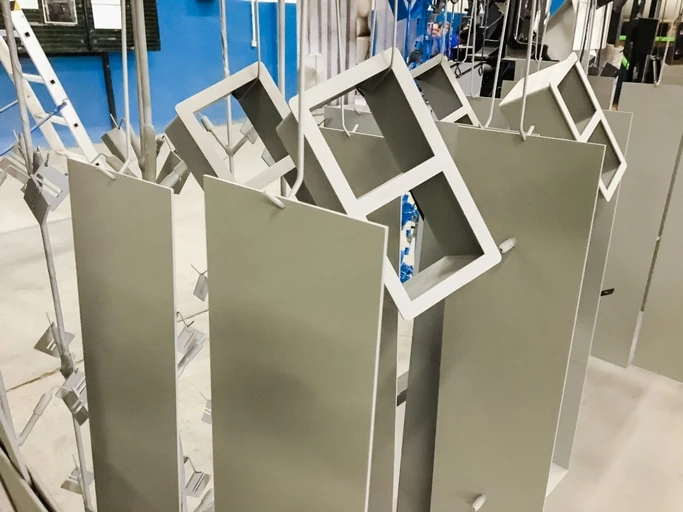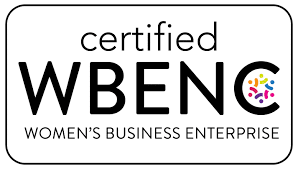Powder coating provides durability and vibrancy to surfaces that are tough to beat and more durable than most painting finishes. Powder coating uses a cutting-edge technique that uses charged particles to create a durable, glossy coating.
Let’s take a closer look at the process and benefits of powder coating and the different types of powder coating options available.
What Is Powder Coating and What Is It Made Of?
Powder coating consists of a fine powder that is applied to a charged surface using an electrostatic charging technique.
Although the powder is inert by itself, the particles that travel through the spray gun give it an electrical charge, and as such when sprayed onto a grounded surface, the particles stick and solidify into a smooth, protective layer that is both appealing and durable.
It is applied as a free-flowing, dry powder and consists of a mixture of finely ground particles, colors, and resins. Together, these components make a colorful, protective layer that, once cured, works effectively in a variety of settings.

Types of Powder Coating
To understand what powder coating is, we need to explore the various types available. This will allow us a better understanding of what this remarkable finishing process has to offer.
Epoxies
Epoxies consist of durable epoxy resins while providing exceptional durability and chemical resistance to powder coatings. They are best used in industrial and automotive industries due to their strong shielding as they can withstand harsh environmental conditions and adhere well to steel.
Polyesters
Polyester-based powder coatings are perfect for outdoor use, as they offer exceptional UV, chemical, and corrosion protection. It is used on a variety of substrates such as architectural, automotive, and outdoor furniture due to its adaptability. The coatings provide durability and protection while also adding visual appeal by adding bright colors. Unfortunately, there is a possibility that after extended sun exposure, they might not be as chemically resistant as other coatings, and they might fade or chalk a little.
Super Durable Polyesters
Super durable polyester is intended to withstand greater external weathering and is more resistant to humidity and salt compared to regular polyester.
Their durability makes them perfect for harsh conditions because they keep their color brightness and shine even after prolonged UV exposure. Due to their extraordinary durability, they are at the top of the list for surfaces that require superior protection without sacrificing visual beauty.
Epoxy-Polyester Hybrids
The epoxy-polyester blend is the perfect combination as it includes epoxy with the versatility of polyester. The coatings provide strong protection against corrosion, chemicals, and shock. They exhibit excellent adhesion to metals and other substrates, making them ideal for a variety of industrial applications.
In addition to stabilizing, they also offer a wide range of colors, making them pleasing to the eye. The ability to combine durability with aesthetic choices makes epoxy-polyester hybrids popular, balancing strength and visual appeal in coating needs.
Unfortunately, they do not do well in extreme conditions such as prolonged UV exposure.
Fluoropolymers
Fluoropolymer-based powder coatings redefine endurance through their exceptional flexibility and longevity.
These coatings boast unparalleled chemical, UV, and extreme heat resistance, ideal for harsh environments such as medicinal plants or architectural exteriors
They provide outstanding color retention and remain glossy even after the delay, making them stand out in construction and automotive applications.
Urethanes
Urethane-based powders stand out for their durability and flexibility. It’s known for its impact and UV resistance; they are ideal for exterior applications such as car parts. They provide a warm, smooth color, and urethane strikes a balance between hardness and texture, making it ideal for products that need attractive permanent protection.
How Does Powder Coating Work?
Powders are coated with electrical particles—including resins, pigments, and additives—that are sprayed onto a surface. Due to the electrical attraction, the charged particles stick together perfectly, forming a single coating.
The coating then enters the furnace, where the powder melts and chemically reacts to form a resistant, non-hardening surface. The heat fuses the particles, forming durable bonds that resist chipping, abrasion, and corrosion.
Once cooled, the material comes out with a warm, protective coating. This efficient, environmentally friendly process reduces waste by re-spray application, making powder coating a versatile, sustainable option and environmentally friendly method of surface enhancement in the industry.
What Is the Powder Coating Process?
There are several key steps involved in the powder coverage process, each of which is essential to achieving a flawless look and feel:
Surface preparation:
Surfaces must be cleaned, lubricated, and sometimes pretreated (such as phosphate) to ensure good adhesion.
Powder application:
Electrically charged powder particles are sprinkled on the substrate, creating a uniform layer due to electrostatic attraction.
Powder Curing:
The coating enters an oven where the powder melts, flows, and chemically crosses to form a durable and durable product This step requires precise control of temperature and time.
Cooling:
The coating can be slowly cooled to harden the powder coating, resulting in a firmer finish.
Quality inspection:
Post-coating inspection includes checking for thickness, adhesion, appearance, and performance to ensure that the coating conforms to standards.
Packaging/Assembly:
Once cooled and inspected, the product is ready for packaging or assembly, depending on the intended use.
Benefits of Powder Coating
There are several benefits to powder coating consider such as:
Durability:
Unlike traditional water coatings, it provides a durable, smooth finish and resists chips, scratches, and corrosion.
Versatility:
Available in a wide range of colors, textures, and finishes to suit a variety of aesthetic preferences and functional needs.
Environmentally friendly:
It is filter-free and emits a few volatile organic compounds (VOCs), reducing environmental impact.
Efficiency:
Its electrostatic application reduces overspray, improves material handling, and reduces waste.
Cost-effectiveness:
Long-term savings come from its durability, with no need to re-coat or re-add.
Versatility:
Used in a variety of industries—automotive, construction, appliances, furniture—because of its flexibility and superior finish, making it desirable for a variety of applications there is a top and a bottom.
Recommended Article: Common Powder Coating Finishes Problems and Solutions
Frequently Asked Questions (FAQs) – Powder Coating
What Is Powder Coating Used For?
Powder coatings are widely used in numerous industries for both practical and decorative purposes. It has been used in products ranging from metal furniture and auto parts and appliances to construction sites. Its durability makes it ideal for harsh or high-traffic environments, protecting against scratches, weathering, and scratches.
What Can You Powder Coat?
Powder coating can be used on a variety of surfaces, specifically on metals such as steel, aluminum, and magnesium due to their versatility.
Is Powder Coat Better Than Paint?
Powder coatings offer various advantages compared to traditional liquid paints. It’s durable, and chip, scratch, and fade resistant.
Compared to paint, powder coating is environmentally friendly, emits few VOCs due to its excellent transfer capabilities, and wastes less material due to its high transfer efficiency.
While both have their advantages, powder coatings typically prove superior in terms of durability, longevity, and eco-friendliness, making them desirable because they are widely used.
The Power of Powder Coating
Powder coating remains a robust, versatile, and environmentally friendly solution that increases surface tension in various industries.
From versatility to durability and performance, powder coating continues to show superiority over traditional paint, and sets the standard for surface protection and visual appeal.
Eckstrom Industries uses trusted vendors in our local area to apply powder coat finishes for our projects. Contact us today to get a quote for fabricating your project with a powder coat finish.
Recommended Article: What is Machine Guarding OSHA

